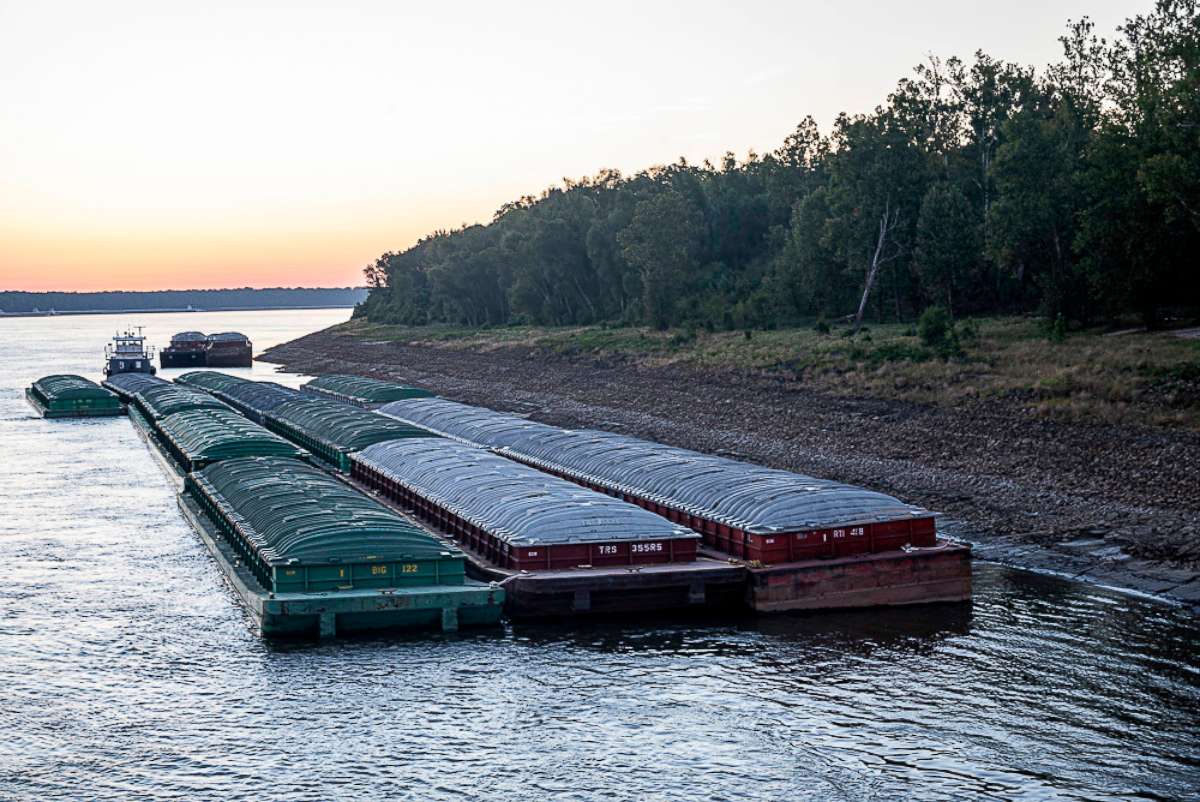Barges idling along Mississippi River sign of supply chain woes to come should drought worsen: Experts
The image of barges idling along the Mississippi River could be indicative of future economic woes should the drought conditions in the Midwest continue to worsen, according to experts.
The lower-than-usual water levels on one of the most important trade routes in the middle of the continental U.S. is causing vessels such as shipping containers, recreational boaters and even cruise lines to stall in mud and sand that was previously covered in ample river water.
While barges stuck on sandbars are not all that unusual for this time of year, experts told ABC News, water levels in the lower half of the Mississippi River are nearing record levels in some areas near and south of the Tennessee-Arkansas border, according to data from the National Oceanic and Atmospheric Administration

Last week, there were nearly 150 vessels and more than 2,250 barges in a queue to float through stretches of the Mississippi River near Memphis Vicksburg, Mississippi, where traffic jams had ensued, the U.S. Coast Guard announced in a statement.
Much of the region surrounding the Mississippi River is experiencing conditions between abnormally dry and severe drought, according to the U.S. Drought Monitor. Regions along the river from Minnesota to Louisiana have been receiving below-average rainfall since August, Mohsen Tahmasebi Nasab, an assistant professor of engineering at the University of St. Thomas in St. Paul, Minnesota, who has researched the Mississippi River extensively, told ABC News.
The drought so far is not "atypical" in the Midwest, as these conditions tend to occur about once a decade, Jonathan Remo, an associate professor at Southern Illinois University's School of Earth Systems and Sustainability, told ABC News.
The last time the Mississippi River saw water levels this low was in 2012, and the biggest drought in recent decades occurred in 1988, Remo said.

However, considering how early in the season it is, the Mississippi could potentially reach record-low levels if the region does not start to receive significant rain events in the coming weeks, Remo added.
"We're not at record yet," he said. "But the potential is there."
Photos Nasab took of the Minnehaha Falls in Minneapolis in May show a gushing waterfall, but images from the same spot in September showed that the waterfall almost dried up due to the lack of rain, he said.


The drought in Minnesota has been a prolonged trend that began in 2021, Nasab said.
The Mississippi River is an essential trade route in the region. Right now is the start of the prime time for grains to move down the river and ship for export through New Orleans and the Gulf of Mexico following the fall harvest, Remo said. In addition, goods like cement, gravel and fuel also frequent the river waters.
Remo expects supply chain delays for many of these goods in the foreseeable future, he said.
The water levels will likely get worse, and recede even more, before they begin to rise again, Remo said.
The core of the Mississippi River is what helps the river maintain water, making it navigable for those large vessels, Remo said. Once the larger sub-basins scattered along the Mississippi are shut off for the winter, usually beginning in early November, those water levels could recede even lower, resulting in more headaches for the supply chain, he sai.
"If that happens, we'll really see it back up, and a potential shutdown of portions of the river for navigation," Remo said.

The consequences of a constantly stalled Mississippi River trade route will be "significant" for hydrology, water resources, engineering, commerce and the economy, Nasab said.
"This is going to interrupt this already broken supply chain, and it's going to exacerbate the situation from the commerce and economic perspectives of the river," he said.
ABC News' Max Golembo contributed to this report.




